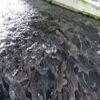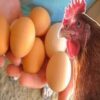The Maize/Corn Peduncle is the stalk that supports the ear of corn, emerging from a leaf axil on the main stem. It bears the weight of the developing ear, which can be substantial as the kernels mature. Structurally, the peduncle is a modified stem with specialized vascular tissues that ensure the efficient transport of nutrients, water, and photosynthates from the leaves and stem to the developing ear. This transport system is critical for the growth and development of the kernels, which are the primary harvestable product of the maize plant.
The vascular tissues within the peduncle include xylem and phloem. The xylem transports water and dissolved minerals from the roots and stem to the ear, essential for cellular processes and kernel development. The phloem, on the other hand, transports sugars and other organic compounds produced during photosynthesis from the leaves to the ear.
This bidirectional flow of nutrients and water is facilitated by the peduncle’s structure, which is adapted to maintain the integrity and functionality of these vascular tissues even under the weight of a fully developed ear.
Anatomically, the peduncle is composed of several layers, each with specific functions. The outermost layer is the epidermis, which provides a protective barrier against physical damage and pathogen invasion. Beneath the epidermis lies the cortex, which consists of parenchyma cells that store nutrients and provide structural support.
The vascular bundles, containing xylem and phloem, are embedded within the cortex and are arranged in a pattern that maximizes the efficiency of nutrient and water transport.
The development of the peduncle begins early in the growth of the maize plant, with its elongation and strengthening synchronized with the formation of the ear. Hormonal signals, particularly auxins and gibberellins, play a crucial role in regulating the growth of the peduncle.
These hormones influence cell division and elongation, ensuring that the peduncle can support the ear’s weight and facilitate the transport of essential resources.
Environmental factors such as light, temperature, and nutrient availability also significantly affect the growth and development of the peduncle. Adequate light is essential for photosynthesis, which produces the sugars transported by the phloem to the developing kernels.
Temperature affects the rate of physiological processes, with optimal temperatures promoting robust peduncle growth. Nutrient availability, particularly nitrogen and potassium, is critical for the development of strong and healthy peduncles, as these nutrients are essential for cellular processes and structural integrity.
In addition to its primary function in supporting the ear and facilitating nutrient transport, the peduncle also plays a role in the mechanical stability of the maize plant. A well-developed peduncle contributes to the overall strength of the plant, reducing the risk of lodging (falling over) under adverse weather conditions such as high winds or heavy rain.
Research into the genetic and molecular basis of peduncle development is ongoing, with the aim of breeding maize varieties with improved structural characteristics and resilience. Understanding the genetic regulation of peduncle growth can lead to the development of maize plants that are more resistant to environmental stresses, thereby enhancing crop yields and agricultural sustainability.
Overall, the maize peduncle is a critical anatomical feature that supports the ear, facilitates nutrient and water transport, and contributes to the plant’s mechanical stability. Its proper development is essential for the productivity and health of the maize plant, making it a focal point of both basic and applied agricultural research.
The maize plant (Zea mays), also known as corn, is a significant agricultural crop globally, primarily due to its versatility and high productivity. One crucial component of the maize plant is the peduncle, which connects the ear (female inflorescence) to the main stem.
This structure is essential for supporting the ear and facilitating the transport of nutrients and water necessary for the development of kernels. The peduncle’s role in plant physiology and its various economic uses make it an important focus in maize cultivation and research.
The Economic Importance and Uses of Maize/Corn Peduncle

1. Grain Production: The peduncle supports the ear, enabling the production of maize kernels, a primary food source worldwide.
2. Livestock Feed: Maize kernels, supported by the peduncle, are a major component of animal feed, providing essential nutrients for livestock.
3. Biofuel Production: Maize kernels are processed into ethanol, a renewable biofuel, highlighting the peduncle’s indirect role in biofuel production.
4. Corn Syrup: Kernels, supported by the peduncle, are used to produce corn syrup, a widely used sweetener in the food industry.
5. Corn Starch: Derived from kernels, corn starch has numerous culinary and industrial applications.
6. Corn Oil: Extracted from kernels, corn oil is used for cooking and in food processing industries.
7. Popcorn: Certain maize varieties produce popcorn, a popular snack, reliant on the peduncle’s support for kernel development.
8. Animal Bedding: Husks and other plant parts from the ear, supported by the peduncle, can be used as bedding material for livestock.
9. Bioplastics: Corn starch from kernels is used to produce biodegradable plastics, an eco-friendly alternative to conventional plastics.
10. Cornmeal: Ground maize kernels, used in various food products like bread and tortillas, depend on the peduncle for proper development.
11. High-Fructose Corn Syrup (HFCS): HFCS, derived from corn starch, is used as a sweetener in beverages and processed foods.
12. Pharmaceutical Products: By-products of maize, supported by the peduncle, are used in the production of certain pharmaceuticals and supplements.
13. Alcohol Production: Maize grains are fermented to produce alcoholic beverages such as bourbon and other whiskeys.
14. Industrial Enzymes: Enzymes derived from maize are used in various industrial processes, including biofuel production and food processing.
15. Cosmetics: Corn oil and other derivatives are used in the formulation of skincare and cosmetic products.
16. Paper and Packaging: Corn stalks and husks, supported by the peduncle, are processed to make paper and biodegradable packaging materials.
17. Traditional Medicine: Parts of the maize plant, including those supported by the peduncle, are used in traditional medicine for their purported health benefits.
18. Soil Improvement: Residual plant material, including parts of the peduncle, is used as organic matter to improve soil fertility and structure.
Read Also Processing of Pig Products and Record Keeping
The Products and By-products That Can Be Derived From Maize/Corn Peduncle

1. Ethanol: Produced by fermenting the sugars in maize kernels, ethanol is a renewable fuel source.
2. Corn Syrup: Made by breaking down corn starch, corn syrup is used as a sweetener in the food industry.
3. Corn Starch: Extracted from kernels, corn starch is used in cooking, baking, and industrial applications.
4. Corn Oil: Extracted from kernels, corn oil is used for cooking and in food processing.
5. Popcorn: A snack food made from specific varieties of maize kernels.
6. Animal Feed: Processed kernels are a major component of livestock feed.
7. Bioplastics: Derived from corn starch, these plastics are biodegradable and eco-friendly.
8. Cornmeal: Ground kernels used in various food products.
9. High-Fructose Corn Syrup: A sweetener derived from corn starch, used in beverages and processed foods.
10. Alcoholic Beverages: Fermented maize grains are used to produce alcohol.
11. Industrial Enzymes: Extracted from maize, these enzymes are used in industrial processes.
12. Pharmaceutical Ingredients: Maize by-products are used in the production of medicines.
13. Cosmetics: Corn oil and derivatives are used in skincare and cosmetic products.
14. Paper Products: Corn stalks and husks, including the peduncle, are processed to produce paper.
15. Biodegradable Packaging: Made from maize plant parts, these materials offer an eco-friendly packaging option.
16. Traditional Medicines: Used in some cultures for their health benefits.
17. Soil Amendments: Plant residues, including peduncle parts, are used to improve soil quality.
Read Also Poultry Records Keeping Books, Types and Benefits
Frequently Asked Questions (FAQ’s) About Maize/Corn Peduncle

1. What is the maize peduncle?
The maize peduncle is the stalk that connects the ear of corn to the main stem, playing a crucial role in supporting the ear and transporting nutrients.
2. What is the function of the maize peduncle?
The primary function of the maize peduncle is to support the ear and facilitate the transport of water, nutrients, and photosynthates from the main stem to the developing kernels.
3. How does the peduncle support kernel development?
The peduncle contains vascular tissues (xylem and phloem) that transport essential nutrients and water to the kernels, ensuring their proper development.
4. Why is the peduncle important for maize productivity?
A strong and healthy peduncle is crucial for the structural integrity of the plant and the efficient transfer of nutrients, directly impacting kernel yield and quality.
5. Can the peduncle affect maize yield?
Yes, any damage or weakness in the peduncle can reduce the transfer of nutrients to the kernels, negatively affecting maize yield.
6. How does the peduncle contribute to plant stability?
The peduncle helps anchor the ear to the main stem, providing mechanical stability and reducing the risk of lodging under adverse weather conditions.
7. What are the anatomical features of the peduncle?
The peduncle consists of an epidermis for protection, a cortex for nutrient storage and support, and vascular bundles (xylem and phloem) for nutrient and water transport.
8. What environmental factors affect peduncle development?
Light, temperature, and nutrient availability are key environmental factors that influence the growth and development of the peduncle.
9. Can the peduncle be used in any industrial applications?
Yes, parts of the peduncle can be used in the production of paper, biodegradable packaging, and as soil amendments.
10. How can breeders improve peduncle characteristics?
Through genetic research and selective breeding, breeders can develop maize varieties with stronger peduncles that are more resistant to environmental stresses and capable of supporting higher yields.
Read Also Best Organic Fertilizer for Vegetables






